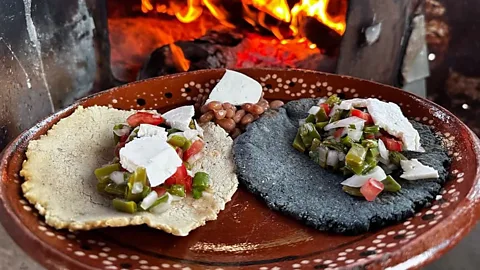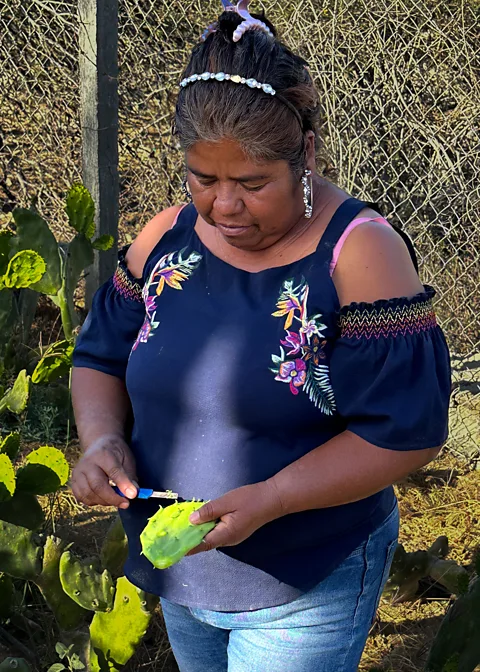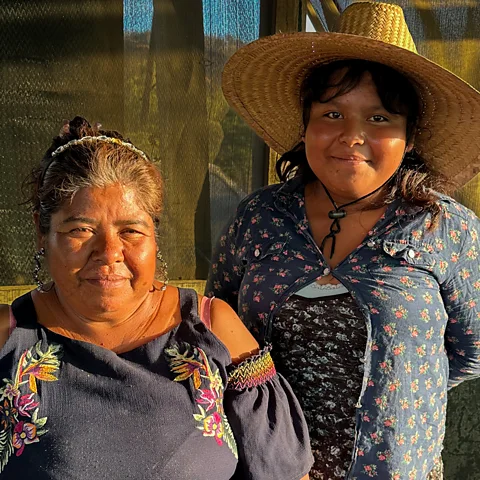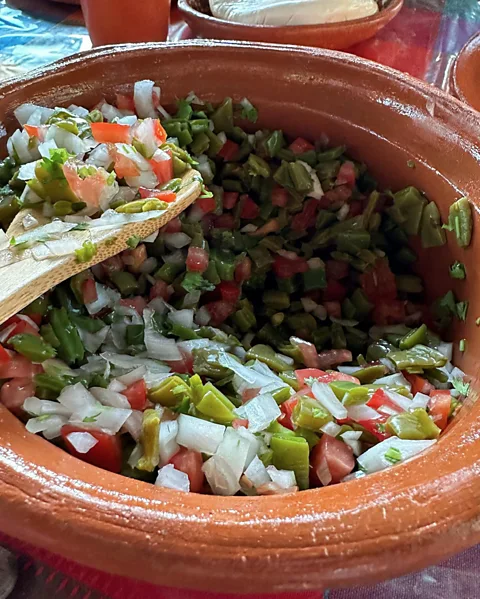Prickly pear cactus tacos
 Danny Perez
Danny PerezIn Mexico, nopales (prickly pear cacti) are mixed with tomatoes into a bright salad and spooned into tortillas with creamy goat cheese and two types of fresh salsa.
Rita Garcia rose to an inky black sky peppered with stars. Quietly, she grabbed a small flashlight on her bedside table, slipped on her shoes, and walked out into the warm desert air to a covered makeshift kitchen. Inside, Garcia sat down on a plastic chair, reached into a large bucket, and carefully grabbed the first nopal (pad of a prickly pear cactus) in just the right place to avoid its thorns. Using a small pocketknife, she skilfully made swift, angled motions turning the pear-shaped nopal ever so slightly to cut off the thorns to perfection.
Once completed, Garcia tossed it into a burlap sack and continued. It was just 03:00 and she had only three more hours until the truck arrived at her family's small ranch to collect her precious cargo – 11 bags in all – and bring them to the market. Like her ancestors, Garcia is continuing a long-held tradition of harvesting nopales, one of Mexico's most beloved food staples.
What took Garcia only five seconds took me, the unskilled guest, five minutes – and I still didn't get it right. Garcia laughed when I showed her my butchered nopal. Despite its appearance, it worked just fine as part of the ensalada de nopales (cactus salad) we prepared for our farm-to-table lunch at her family ranch, El Barranco, located 30 miles north of Cabo San Lucas in Mexico's Baja Peninsula.
 Nicole Melancon
Nicole MelanconKnown as one of the most traditional ingredients in Mexico, nopales are making a comeback. This nutritional food can be found almost everywhere – from Mexican homes, taqueros (taco vendors), restaurants and cooking classes to now infiltrating America's Southwestern cuisine.
"The nopal cactus comes from a Nahuatl word 'nohpalli' dating back to pre-Columbian times," said Danny Perez, our guide from Dharma Expeditions, a Los Cabos-based outfitter that connects travellers with the ranchero (rancher) community for a traditional cooking class. "This cactus is deeply woven into our culture and national identity," Danny explained as we toured Garcia's family farm. "It can be found on our flag, in art, and even within ancient mythology based on the founding of Tenochtitlán, the ancient Aztec capital, and modern-day Mexico City. It is very symbolic for the Mexican people."
As we walked past the goats, the native desert scrubs and a small family garden, it was easy to see why the cactus has become so embedded in Mexican life. It grows everywhere, reproduces easily and flourishes even in harsh climates like Mexico's Baja Peninsula. In a place that receives very little rain, cacti not only survive but also thrive – just like Garcia and her ancestors who have lived and worked off this arid, inhospitable land for centuries.
As Garcia showed us how to pick out the perfectly ripe nopal pad – the ones that are young and vibrant, almost electric green in colour – she told us that nopals are the most tender and juicy in the spring but can be harvested year-round.
With the taste of a slightly tangy green bean and its ability to be added to almost every meal, nopales have been an important dietary staple for centuries. They are extremely healthy, nutritious and versatile. Packed with vitamins, minerals and dietary fibre, one nopal pad can fill a hungry stomach for hours, Garcia explained. That is why they can be found as a mainstay in almost every Mexican home.
"You can do everything with this cactus," said Garcia while she helped us prepare our meal. "You can boil it, grill it, eat it raw as a juice or add it to a stew, salsas or eggs."
"It is a Mexican 'superfood'," her daughter Joycelyn laughed.
 Nicole Melancon
Nicole MelanconBesides the pad, nopales also bear a small oval-shaped fruit called the tuna, which has a sweet taste that's similar to watermelon and is used in juices, cocktails and jellies.
As we assembled the tomatoes, onions, garlic and coriander for the salad– all picked fresh from the farm – we had a quick lesson in slicing nopales from Jocelyn. "Hold them steady while you slice, first lengthwise and then across the width," she instructed. Nopales are notoriously sticky and gooey as they are filled with mucilage, a thick gluey substance that is the keeper of the cactus' fibre.
We boiled our coveted nopales over a traditional charcoal grill and waited. Ten minutes later, the nopales were cooked to perfection, drained, and left to cool. We prepared the salad while Perez played his guitar.
Finally, it was time to assemble our first taco. I grabbed a freshly made blue corn tortilla, filled it with ensalada de nopales, salsa roja and salsa verde and fresh goat cheese made at the farm that day.
"This is the true meaning of farm-to-table dining," Garcia beamed as we listened to the goats' bleat.
 Danny Perez
Danny PerezServes 4-6
The most popular way to enjoy nopales is as a taco, and preparing it is simple. You don't have to look around for a cactus farm in the heart of the Mexican desert to find the perfect nopal cactus. Instead, stop by a local Mexican or specialty grocery store and buy a pack of 4 to 6 harvested, washed nopal pads. The first thing you notice when you slice into a nopal is its sticky, gooey texture. Rest assured; this will dissolve when cooking.
Ingredients
For the nopales:
4-6 fresh nopal (cactus) pads
6 large ripe tomatoes, diced
½ onion, diced
½ cup coriander, chopped
salt and pepper
juice of two limes
For the salsa roja:
2 boxes cherry tomatoes
1 serrano pepper, diced
2 garlic cloves, peeled and chopped
salt and pepper
For the salsa verde:
6 ripe tomatillos (green tomatoes), husked, washed and sliced horizontally
1 serrano pepper, halved
2 unpeeled garlic cloves
½ onion, diced
¼ cup fresh coriander, chopped
salt and pepper
1 small lime
To assemble the tacos:
1 package of corn or flour tortillas (12 count)
one round of fresh goat cheese (175g-225g/6-8oz)
Method
Step 1
Make the nopales. Cut the nopales vertically in strips and then cut again horizontally. Put in a pot, cover with water and bring to a boil. Boil on medium-high heat uncovered for about 10 minutes, or until the nopales are tender and the mucilage (a gelatinous sticky substance) has seeped out. Pay attention as the mucilage may begin to foam and spill over. If that happens, lower the heat. Drain and let cool.
Step 2
Once the nopales are cool, place in a large bowl and add the tomatoes, onion and coriander, and season with salt and pepper to taste. Sprinkle with fresh lime juice.
Step 3
Make the salsa roja. Bring a medium saucepan of water to a boil. Add the tomatoes and serrano pepper and boil over medium-high heat under tender, roughly 7-10 minutes. Drain and add the tomatoes to a bowl.
Step 4
Remove the seeds from the serrano pepper (leave some if you want extra spice). Dice and add to the tomatoes. Use a mortar and pestle (or blend briefly in a food processor) to mash the tomatoes with the serrano pepper. Add the garlic to taste and season with salt and pepper. Add water if you prefer more liquid in your salsa.
Step 5
Make the salsa verde. Light your oven's grill (broiler). Place the tomatillos in a baking dish, skin-side up. Add the serrano pepper and garlic, and roast under the grill for 10-12 minutes. Remove when the skins are turning black in colour.
Step 6
Remove the seeds from the serrano pepper (leave some if you want extra spice) and peel the garlic. Toss the tomatillos, serrano pepper and garlic in a mixing bowl and crush everything together with a mortar and pestle (or blend briefly in a food processor). You may add a minced fresh serrano pepper if you prefer more spice.
Step 7
Add the onion, coriander, salt and pepper, and squeeze over fresh lime juice to taste.
Step 8
Assemble the tacos in tortillas with the ensalada de nopales, goat cheese and the salsa of your choice.
BBC.com's World's Table "smashes the kitchen ceiling" by changing the way the world thinks about food, through the past, present and future.
---
Join more than three million BBC Travel fans by liking us on Facebook, or follow us on Twitter and Instagram.
If you liked this story, sign up for the weekly bbc.com features newsletter called "The Essential List". A handpicked selection of stories from BBC Future, Culture, Worklife and Travel, delivered to your inbox every Friday.
